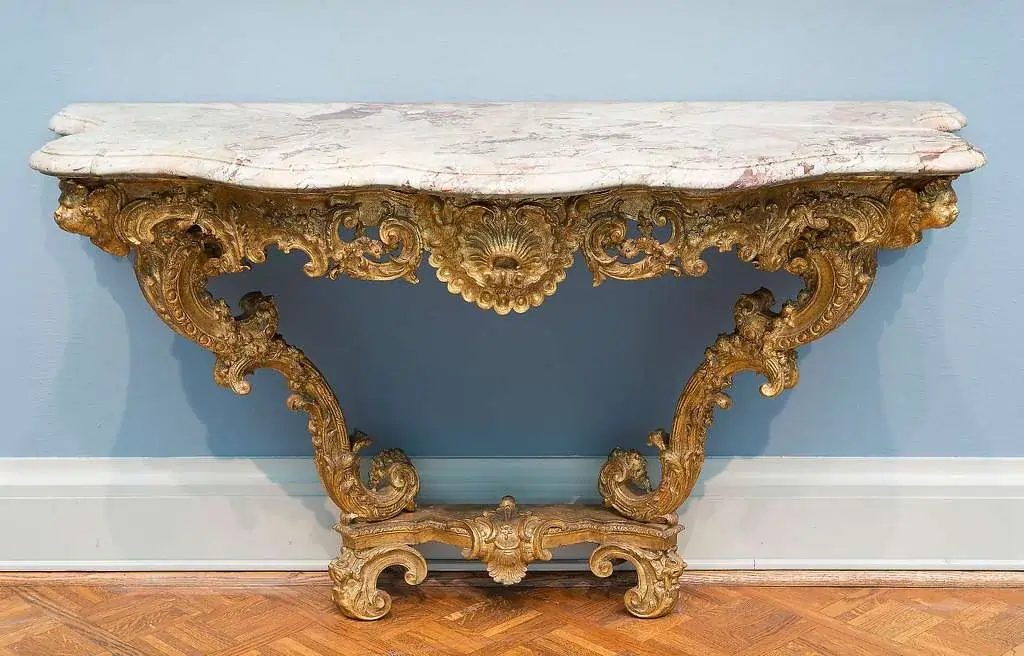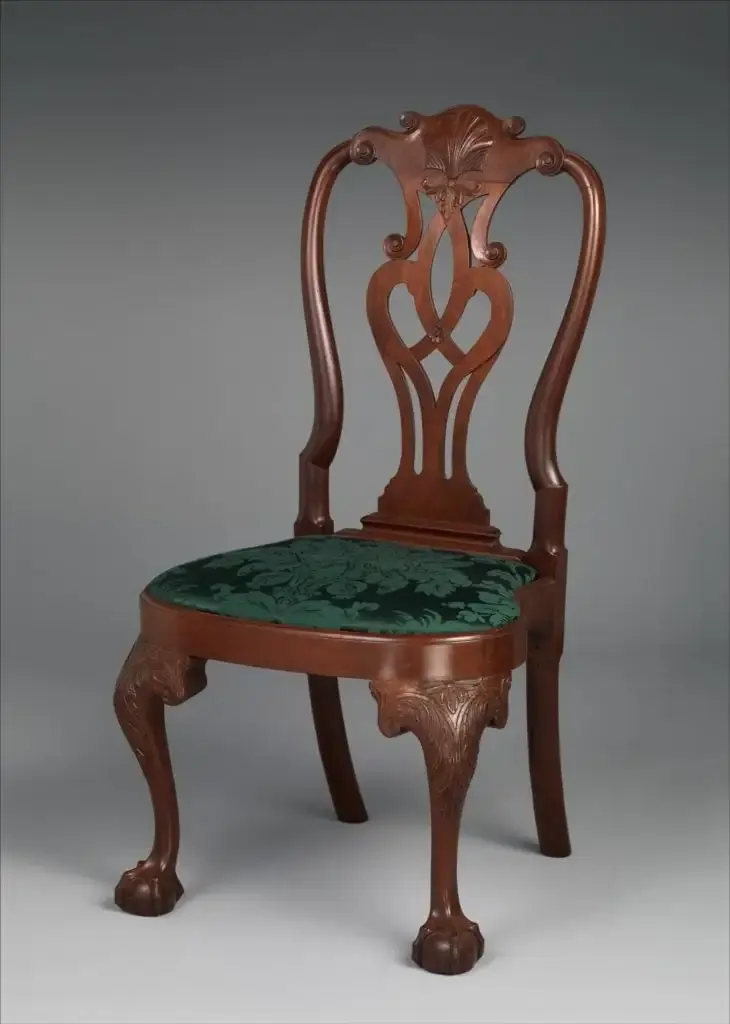French console tables are revered as examples of furniture craftsmanship that have adorned the corridors of Versailles and various royal residences, for generations now These sophisticated furnishings were initially meant to be affixed on walls flanking windows but evolved over time into breathtaking pieces of ornamental artistry Lets delve into the history, behind the iconic French console table and its representation of French expertise and opulence
Antique French console tables have narratives that span epochs – from the opulence of Louis XIV, to the elegant nuances of the Rococo era. Through exploring their progression over time we will uncover the characteristics, materials and methods that rendered these pieces treasures, for collectors and delve into the skilled artisans who defined their enduring influence.
Table of Contents
ToggleOrigins of French Console Table
The French console tables origins can be traced back, to 17th century France when it first appeared as a piece of furniture design. The initial concept involved wall mounting these consoles with a half-moon shape supported by curved brackets called ‘consoles’ hence the name derivation.
Evolution from Medieval Wall Tables
The earliest French console tables represented a significant departure from medieval wall tables. We can identify their unique characteristics:
- Half-moon or crescent shape design
- Wall-mounted configuration with S-shaped brackets
- Decorative front legs added by French architects
- Limited weight-bearing capacity
Introduction to French Palace Decor
Console tables went through a change during the time of Louis XIV as they played a role, in adorning palaces at that time period. These antique French console tables, from that era were usually crafted in pairs. Paired with mirrors to create a balanced and harmonious look that characterized the interiors of French palaces.
Role of Royal Craftsmen
Craftsmen, with skills in building construction known as menuisiers en bâtiments were tasked with producing these pieces of furniture craftsmanship We appreciate their proficiency in making permanent interior fixtures, like paneling pier glasses and console tables These skilled artisans used advanced methods to craft the curved shapes detailed decorative ornaments and elaborate floral decorations that defined antique French console tables
The artistry peaked in the 1700s when these pieces transformed from decorations to practical furniture pieces we see today. Artisans skillfully added elements, like uniform rocaille frames and elegant floral patterns that set the trend for furniture design, across Europe.
Distinctive Design Elements
Examining French console tables carefully reveals a variety of design features that distinguish them from other pieces of furniture. These features come together to form items that are not practical but also visually stunning.
Signature Decorative Features
We find that authentic french console tables showcase several characteristic ornamental elements:
- Serpentine outlines with gracefully curved aprons
- Intricate cartouches featuring heart-shaped bosses
- Scrolling acanthus leaves and floral garlands
- Scalloped edges and openwork details
- Asymmetrical rocaille frames
Common Materials and Finishes
During our analysis of these items we noticed that artisans mainly utilized high quality woods in their craftsmanship efforts. The used materials consist of walnut durable poplar, and robust birch wood. Notably maple was employed for components such, as beadboard backs. The final touches vary from distressed French green to warm, honey-toned patinas that gain personality with age.
Regional Style Variations
Throughout Frances regions you can observe styles that have shaped the design of console tables. Normandy showcases carve depicting themes of love and success. In the Loire region the emphasis is, on styling and subtle embellishments. Provence stands out with its decorations, including panels and elaborate carven edges.
In the Burgundy areas console designs frequently combine types of wood and geometric motifs for a look in contrast to this style are the pieces from Brittany known for their straightforward rectangular shapes and delicate carved details. Vintage French console tables originating from the Lorraine region showcase a focus on intriguing wood grain patterns and burled finishes, than elaborate decorations.
The differences, in styles, from regions don’t only show tastes but also the use of local materials and cultural inspirations that come into play when looking at an old French console table. This helps us trace back where it came from by noticing the features that have been passed down through years of artistry.
Historical Periods and Styles
Exploring the history of furniture reveals changes, in the design of French console tables over three different time periods, with unique artistic styles and cultural impacts shaping these exquisite pieces.
Louis XIV and Baroque Influence
During Louis XIV’s reign, in France the splendor of the period style was at its peak We witnessed the influence of aesthetics in elegant and grand designs that showcased intricate details and precise craftsmanship This era brought forth console tables adorned with symmetrical decorations balanced ornamental elements and a significant incorporation of anthemion’s and acanthus motifs The craftsmanship highlighted opulent yet refined ornamentation, with marble and granite surfaces accentuated by gilded embellishments
Rococo Period Innovations
Moving into the Rococo period, we witness a remarkable shift in design philosophy. This era introduced:
- Asymmetrical cartouches and serpentine lines
- Lighter, more delicate forms
- Theatrical and ornamental styling
- Nature-inspired motifs including rocks and shells
- Curved cabriole legs imitating tree limbs
We find that these vintage French console tables often featured white or pastel finishes, creating an overall lightness that contrasted sharply with the previous period’s heaviness.
Neoclassical Transformations
During the 1750s era of design or Louis XVI style blossoming took stage noticeable changes, in antique French console table designs unfolded before our eyes gracefully and powerfully merged with elements derived from ancient Rome and Athens were reflected in these pieces showcasing symmetrical and ordered forms marked by tapered and fluted legs scrolled arms as well as architectural details such, as friezes and pediments being distinct features of the era.
During the era these designs were elevated with gold and silver accents, intricate wood inlays and ornate symbols inspired by Greek and Roman art. Notably we observe the incorporation of details, like acanthus leaves garlands, wreaths of laurels and ornamental medallions that showcase craftsmanship and elegance.
Famous Craftsmen and Workshops
The stunning French console tables we’ve talked about have a history crafted by artisans who played a crucial role in the golden era of French furniture production.
Notable Cabinet Makers
We recognize several master craftsmen who revolutionized console table design. François Roumier, appointed as sculpteur ordinaire du roi in 1721, created masterpieces for royal residences, including a magnificent carved table for Louis XV’s private apartments in Versailles. We find that Jean-Henri Riesener became the primary cabinet maker to the royal court, earning particular favor with Marie-Antoinette through his exceptional naturalistic marquetry work.
Royal Workshop Contributions
Royal furniture makers had benefits such, as working in workshops at the Louvre palace and the Manufacture Royale des Meubles de la Couronne, at the Gobelins where they were not bound by guild rules and could freely express their creativity while upholding high quality standards.
- Mandatory stamping of furniture with maker’s marks
- Regular inspections by committee members
- Confiscation of substandard pieces
- Implementation of innovative techniques
Signature Techniques
The Corporation des Menuisiers categorized craftsmen into two groups; the menuisiers who crafted wood furniture such, as console tables and the ébénnistes who specialized in veneered case pieces. The majority of artisans born in France operated their workshops near the rue de Cléry whereas ébénnistes from countries usually set up their workshops in the Faubourg Saint Antoine area.
The remarkable outcomes were achieved through the teamwork of experts, in the field. Bronze craftsmen, gilders and artisans skilled, in polishing and leatherwork came together to craft stunning vintage French console tables. Their methods included crafting marquetry designs applying Scagliola finishes and incorporating detailed carved elements adorned with maple leaf and acanthus motifs.
Today we still see some workshops sticking to these old school techniques at Cour de l’Ours where contemporary craftsmen carry on the tradition of refurbishing console tables and crafting fresh pieces based on time honored designs and models to uphold the heritage of those who came before them.
Conclusion
French console tables serve as timeless representations of brilliance and exquisite craftsmanship with a touch of extravagance woven into their design fabric. As we delve into their captivating history and evolution over the years we observe how these once humble wall fixtures have evolved into pieces that shaped the ambiance of palaces throughout France.
The exceptional works, on display demonstrate the examples of furniture craftsmanship with their unique regional traits and use of luxurious materials that reflect the evolution of styles from the grandeur of Louis XIV to the delicacy of Rococo and the refinement of Neoclassicism. Skilled artisans in workshops and specialized guilds transformed the crafting of console tables into an art form by setting standards and techniques that have left a lasting impact, on the world of furniture making.
The enduring influence of these creations endures with the presence of preserved artifacts and modern craftsmen who continue to uphold age old crafting techniques. Their everlasting charm serves as a reminder that genuine artisanship exuding contours, sophisticated inlays or impeccable balance always retains its ability to fascinate and motivate.



